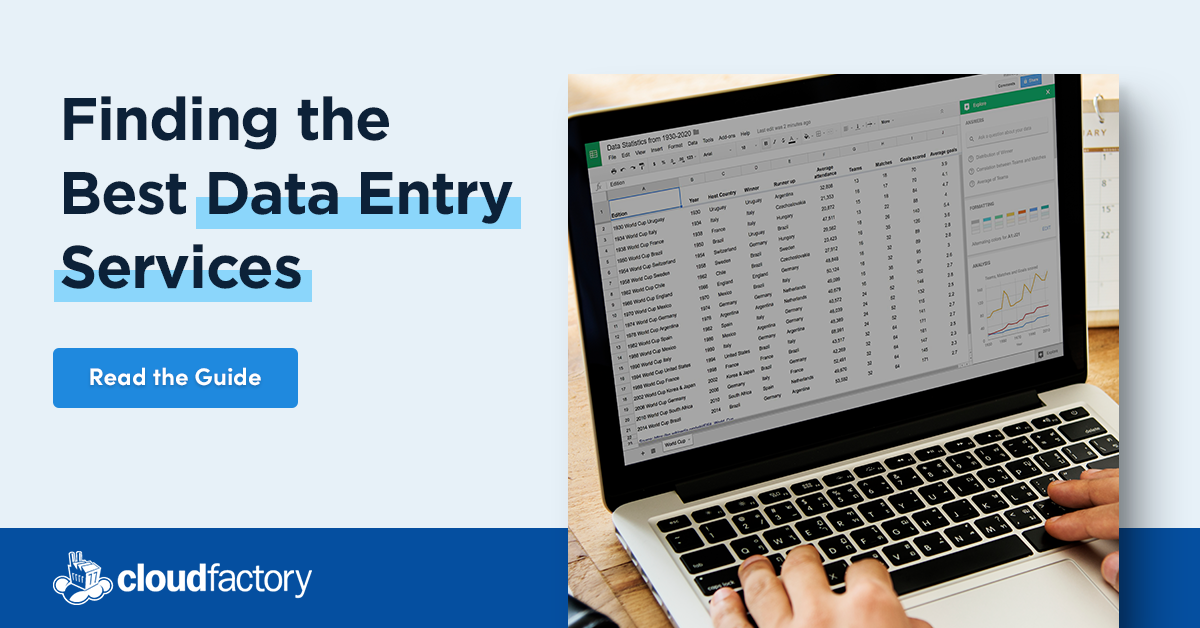
The accuracy and maintenance of your data is critical to the development of your business. As companies across every industry embark on their digital transformation journeys, it’s normal to run into issues with scale and quality. After all, the amount of data being generated is massive, with every person in the world generating an average of 1.7 megabytes every one second.
When should you outsource data entry?
Data entry should not weigh down your core business operations. It should not burden employees either, whose time may be better spent on other tasks, and it’s not often economical to hire a dedicated in-house team to manage data entry. Fortunately, data entry service providers offer an opportunity to transform your data into a valuable asset.
Data entry services tend to offer the best value when you have large amounts of text or audio content that needs to be transcribed, cleaned up, enriched, or digitized. This is often the case for established organizations that have huge quantities of records in printed and legacy formats that need to be digitized. In the legal sector, for example, the transcription of archived records can assist with electronic discovery and help streamline legal contract review.
1. Overcome the challenges of scale
Digital transformation is a process of continuous improvement, rather than a final destination. As such, to support continuing business growth and meet the evolving needs of the market, your approach to data entry and management needs to be scalable and adaptable.
Constantly hiring new employees to tackle your growing data challenges is hardly feasible. It takes an average of eight months for a new hire to reach full productivity, and it’s a costly and risky endeavor. In other words, in-house teams lack scalability. Additionally, data entry is monotonous work that typically increases turnover rates.
Using a data entry services provider, however, lets you shift the burden onto an external team. For example, outsourcing the work to a trained, managed workforce provides scalability and accountability without the communication and quality control issues commonly associated with crowdsourcing.
2. Improve the quality of your data
Data entry may seem like a low-skill task, and in many cases, that may be the case. But the quality of that data entry and its consistency across a set of data can be critical. If you are digitizing records to use data more strategically, your project is doomed to fail if those newly digitized records contain errors and inconsistencies. And in industries like healthcare and finance, high quality data is essential where incorrect data can mean life or death.
While your internal team might have the industry-specific knowledge to carry out data entry tasks themselves, that doesn’t mean they should. For example, there are far better uses for a registered nurse’s time than manually transcribing medical records. If your team is being taken away from their core roles to complete tedious tasks, there’s a greater chance of reduced job satisfaction and higher turnover, both of which also can compromise the quality of your data.
Of course, data entry services come in varying degrees of quality, and it’s important to consider the options carefully. Crowdsourcing, for example, lacks oversight and accountability. By contrast, data entry services that provide onboarding and training, such as CloudFactory’s managed workforce, can offer greater attention to detail and quality control.
3. Address edge cases quickly
Although data entry is often associated with monotonous work that might be better completed by automated processes, there are plenty of situations where edge cases may arise, and you’ll need people to consider and moderate those situations. While automation has advanced to such a level that it can perform most routine data entry tasks with minimal human intervention, it always comes with an error rate. For example, optical character recognition (OCR) has an error rate between 5% and 20%.
Fortunately, automation itself can help identify any potential issues with automated data entry and transcribing, thanks to exception-monitoring algorithms. However, they still require human-in-the-loop intervention to make manual corrections. This is something that takes time, and it can get overlooked when you’re working with an in-house team.
The best data entry services leverage an optimal blend of people, processes, and technology to address edge cases quickly and efficiently, without leaving anything to chance.
4. Reduce project cycle times
Data entry projects should never be rushed, and there should be no compromise on quality control, especially in the case of sensitive transcriptions like legal or medical records. That said, timeliness is important, especially where the data in question can offer immediate value and importance to your business. After all, data tends to be more useful the sooner it’s captured.
Chances are your in-house team already has ample work to do and other commitments they need to address. Overburdening them with data-entry tasks can quickly result in burnout and increased staff turnover, especially if it’s taking attention away from their primary roles. Additionally, in-house teams work during typical office hours, and overtime can be expensive. Outsourcing to a data entry service allows work to be processed while your in-house team is sleeping.
By accommodating the challenges of scale and speed, the best data entry services can greatly reduce project cycle times without compromising on quality.
At CloudFactory, we have more than a decade of experience providing data entry and data processing. We have worked on use cases as simple as transcription for database enrichment and as complex as image annotation for self-driving vehicles. To learn more about outsourcing data cleansing, transcription, and enrichment at scale, check out our helpful guide, Finding the Best Data Entry Services.
Outsourcing Data Transcription Workforce Strategy Automation & Back Office Support Data Entry



